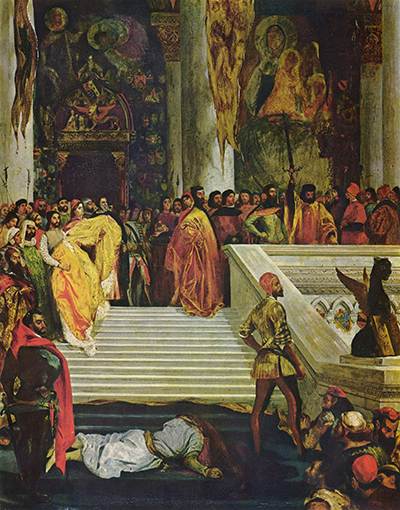Marin Falier, the Doge of Venice, was executed on April 18th, 1355. Eugene Delacroix chose to use this event as inspiration for a painting which he completed in 1825–1826.
Lord Byron wrote Marino Faliero, Doge of Venice in 1820 and this is known to have pricked the artist's interest. Byron was someone who Delacroix hugely respected and also they were closely aligned as part of the Romanticist movement, spearheading the literature and art strands respectively. Many French artists from this period would take modern literature from the time which brought to life scenes from past nations, even civilisations, and use it as inspiration for their work. Jacques Louis David did the same with Greek-inspired novels and poetry, as seen in the likes of The Oath of Horatii and The Intervention of the Sabine Women. He was a Neo-classical artist and so his content would always be different from Delacroix, but they offer an important contrast between the old and the new, with the younger artist now being seen as bringing fresh ideas that would replace the art of before that was starting to appear stale.
The Doge was appointed in 1354 but was executed a year later after allegations emerged of him 'conspiring against the state'. The artist took not only inspiration from Venetian history for this work, but the bright tones of colour are also heavily connected to the style of the Venetian Renaissance, which became one of the key regions of innovation during this critical time in western art. Members of that group included the likes of Giorgione, Titian, Tintoretto, Paolo Veronese and Jacopo Bassano. Indeed, he was already known to have been an admirer of the extraordinary work of Titian, but then so many were that this was not in any way surprising. Some have claimed that individual figures were inspired by this self portrait of Titian from 1567-1568. The tall stairs have been given a key part of the composition here and they were mentioned within the texts that inspired this work. It also offered Delacroix an opportunity to display his skills of architecture once again.
This powerful painting is known to have been personally loved by the artist himself, above all others from this part of his career. Despite receiving mixed reviews upon its first unveiling, due to the lack of a moral message, it is now highly respected by experts on this artist. It can be found at the Wallace Collection, an exciting venue in central London which displays a range of art and antiquities within a classical building. Most exciting here would be the range of Canaletto paintings as well as the world-famous The Swing, by Jean-Honore Fragonard. They also possess a good number of Dutch maritime artworks within this varied and prominent collection. This institution is often forgotten when placed against the mammoth National Gallery and various Tate venues, but it truly holds an enviable selection of items that even the most occasional art history follower would find joy with a single visit.




